Evaluating Samsung's QHD AMOLED Displays
by Joshua Ho on July 16, 2014 6:00 AM EST- Posted in
- Smartphones
- Samsung
- Mobile
- Laptops
- Snapdragon 805
- Galaxy S5
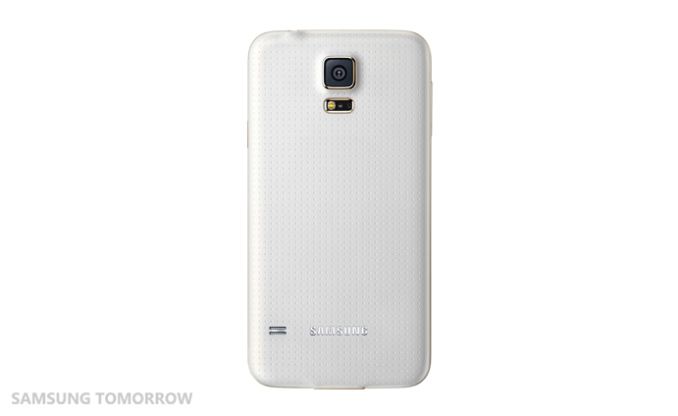
Recently, a package showed up at my door. While this is normally not worth talking about, the Galaxy S5 Broadband LTE-A happened to be in the box. For those unfamiliar with this phone, it's basically a refresh of the Galaxy S5. This means a Snadragon 805 SoC instead of Snapdragon 801. This also means a minor new revision of Krait (450 vs 400), a new GPU, and a separate MDM9x35 modem on a new process (20nm SoC vs 28nm HPm). This variant also ships with more RAM (3GB vs 2GB) and more internal storage (32GB vs 16GB). The display is also higher resolution (2560x1440 vs 1920x1080).
In terms of the resolution itself, the GS5 Broadband LTE-A doesn't seem to hold a significant advantage over the original Galaxy S5. While it's still possible to see the difference, once again I don't find it to be significant. It may be of value to others, but I think the PPI race needs to stop here, as I find it hard to justify the relatively minor resolution increase over the potential battery life gains and opportunity cost of pursuing higher pixel density over other display characteristics. Going to 4K would make even less sense at this display size, although there may be value to 4K in a tablet display. In the case of this display, I only see around a 10 nit reduction in brightness as the maximum luminance in auto brightness is around 430 nits, while on the older Galaxy S5 it was 440 nits. When set manually, the display has a peak luminance of 368 nits, a minor improvement over the previous model.
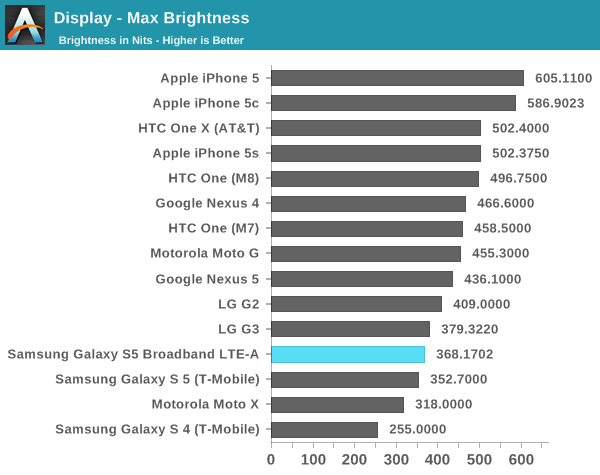
Of course, resolution isn't everything. Testing color accuracy is also important, which is the real surprise here. As always, these tests are run using an i1Pro for all measurements but contrast, and done using a custom workflow in SpectraCal's CalMAN 5. All color/grayscale measurements have been done in cinema mode as it is closest to targeting sRGB.
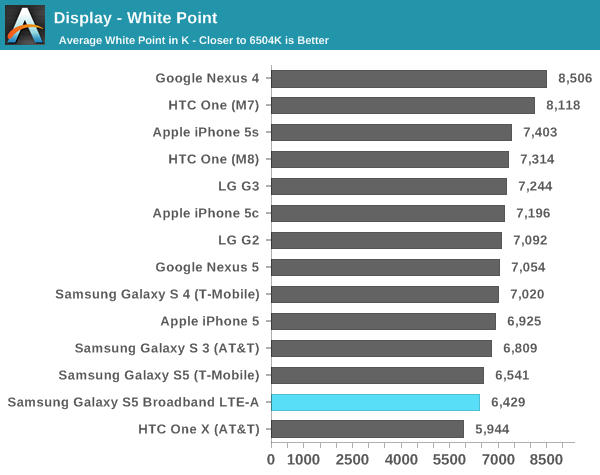

Based on grayscale alone, Samsung sets a new record for color accuracy in this department. It's definitely a healthy leap forward from the original Galaxy S5. In subjective viewing there are still some minor issues with excessive green in the color balance, but it's much better than before. The contrast is still just as dark as before. In a completely dark room, I can't tell whether the screen has turned off when displaying an all-black image.
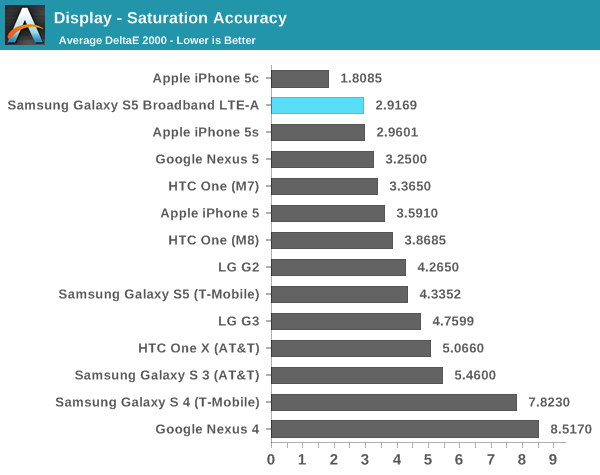
In saturations, Samsung has done an incredible job of calibrating the display. Just looking at the graph of dE2000 averages, there is clear improvement from generation to generation. Samsung is now tied with Apple for color accuracy in this department.
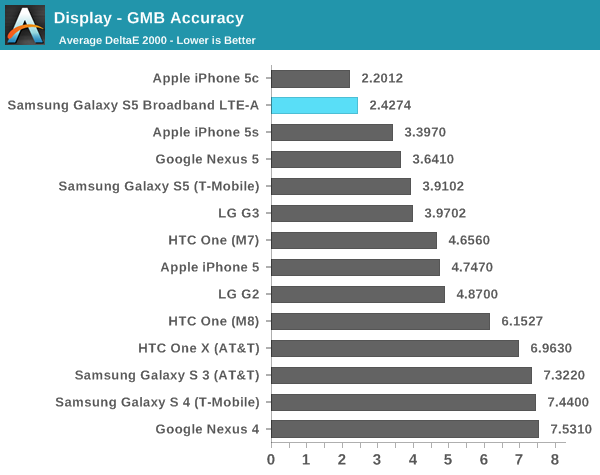
While the saturation test is important, it's often not as rigorous at the GMB ColorChecker test. It's fully possible for a display to do well in the saturation test but fall flat in this one. Fortunately, this isn't the case here. Samsung has managed to approach the iPhone 5c in calibration accuracy here, easily setting a record amongst Android OEMs. The difference in color is definitely noticeable when compared to a Galaxy S5, and I hope that every Android OEM follows Samsung's lead in this department.
Based upon this initial evaluation of Samsung's first quad HD AMOLED display, things are looking good. There is a small drop in the maximum luminance but nothing significant. The next critical piece of the puzzle is whether power draw is significantly worse on the Galaxy S5 Broadband LTE-A, although those results and the full review aren't quite ready yet. While only one aspect, things are currently looking up for the GS5 Broadband LTE-A, even if the name is a bit long. This may also represent a change in the future of mobile displays, as AMOLED increasingly seems poised to supplant LCD technologies. Unfortunately, as Samsung seems to be the sole supplier of such displays other OEMs are unlikely to adopt AMOLED until other vendors catch up with equivalent technology.


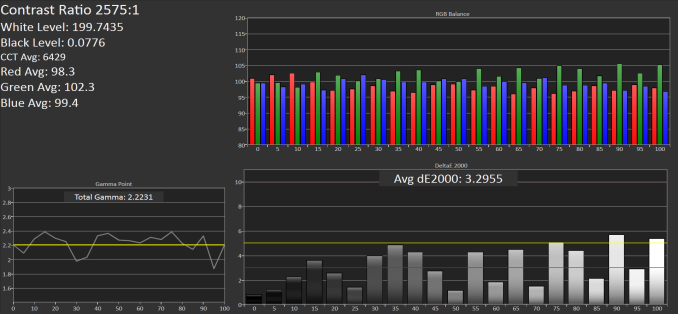

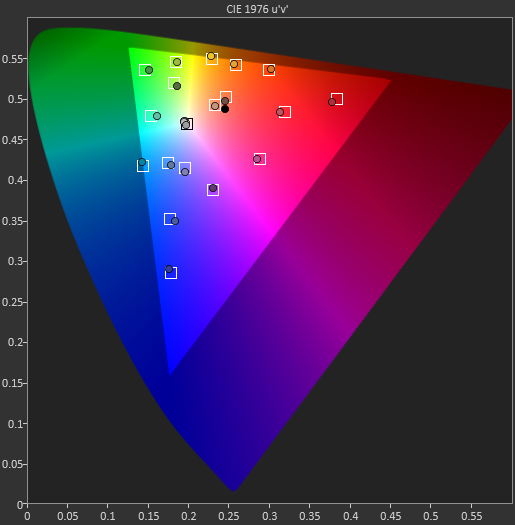








71 Comments
View All Comments
jwh635 - Wednesday, July 16, 2014 - link
I thought OLEDs consumed less power than LCDs?frostyfiredude - Wednesday, July 16, 2014 - link
Displaying dark colours they do, bright ones have AMOLEDs using more power with current technologies.xmen77 - Wednesday, July 16, 2014 - link
In some tests it walked around even kings of calibration (Apple)And this despite the fact that the iPhone is no ideal black, no ideal contrast, no ideal response time, no ideal viewing angle, because LCD display (IPS)
akdj - Friday, July 18, 2014 - link
iPhone, 'no ideal black?' You said it yourself. It's LED/IPS. not AMOLED. When 'black' is the absence of light, AMOLED rules the roost. It's pixels are 'off'. LCD and LED/IPS doesn't have the luxury, nor do any other non AMOLED panels. That said, it doesn't suck. Apple's 'calibration' out of the box is and had been second to none. As a user of both a 5s and Note 3 I appreciate the differences, as well, how far Samsung has come in just a year with the technology. The Note 3 was the AMOLED display I finally found 'decent'. Still saturation challenges. Still gray scale, colors...and their ability to be semi controlled by Adapt screen's setting, it's the closest to an 'iPhone' as I've seem when it came down to ALL visual factors taken in combination. Apple's displays, that continue to stack up well to today's flagship Android devices are now a year old from their original production (5c/5s) and the Air, also a year old sits atop the best two or three. When it comes to viewing angle, it's hard to get better than iOS. iPad. iPhone. Latest generation iPods and MacBook retina displays. They're right at about 178°. That two degrees can get annoying but you're not going to get it with AMOLED. When you're talking response time, as an owner of the original Xoom, a half dozen Android phones, three other tablets and each iPhone and iPad I can honestly say, you're a bit 'off' when it comes to fact. Again, I own and enjoy them both. Love me for differ t things and flagship to flagship, iOS generation in, generation out, has ALWAYS been more responsive, faster and 'immediate' than ANY Android build. I'll admit, my Note3 is the fastest yet but I've got a half dozen 'cross platform' and different apps that show 'response time' and the real truth. Whether playing Asphalt 8 or Temple Run. Opening and accessing Dropbox or ANY browser on Android, from stock to Chrome, Dolphin to Opera, Mercury...I've got plenty. iOS trumps them all. And in spades. From launch to population of the screen, the iPhone 5s with ½ the cores @ 40% less clock speed and ⅓ the RAM absolutely SMOKES any of my Android devices I own and have used. It's sad, but it's the truth. GPS and location related applications (I'm a pilot and use ProPilot and ForeFlight as well as a half dozen others with up to date Jep charts, plates, weather and traffic conditions, even TCAS and 'moving map' ADS-B 'Next Gen' technology. Instantaneous lock. Amazing accuracy and phenomenal terrain, traffic and weather 'radar' on a retina iPad mini. That has replaced a 50lb flight bag (still in the plane JIC). And I fly in and all over the state of Alaska with amazing sunshine, around the clock these days...and my 'contrast' challenges, even on the mini are non existent. I'm not a fan of watching movies on my phone though and in that situation, I can see the appeal;)mkozakewich - Tuesday, July 22, 2014 - link
All generalizations are wrong.I'm the type of person who noticed how dull the colours were on the iPad mini. (I think it was last year's?) It was still better than basically all other displays except that year's iPad and iPhone, but I'd had the opportunity to see the iPhone's screen before, and I did notice in casual viewing.
You can say that people don't care about this or that, and it's true that most won't really know why they don't enjoy a system that much, but when they see something better they can usually recognize it.
Back in the 90s, my mom had the good sense to get a very good monitor with her cheaper computer, because she knew the performance differences would be minor, but you'll be intimately familiar with what you see every day.
victorson - Wednesday, July 16, 2014 - link
There's a typo in the title - should be Samsung, not Samsung. Otherwise, great read, glad to see the improvements in AMOLED. Still appears to be a bit greenish looking at the charts, no?morganf - Wednesday, July 16, 2014 - link
There's a typo in your comment. Should be "not Samung" not "not Samsung".JoshHo - Wednesday, July 16, 2014 - link
Oops. That was a pretty terrible typo, thanks for the catch.It definitely is a little bit on the green side at times. While this tends to be acceptable to a certain extent near 100% white, it's quite obvious when closer to 50% white. It's definitely a lot better than the Galaxy S5, which had some shades of gray more green than gray...
victorson - Wednesday, July 16, 2014 - link
Thanks for clarifying this, Josh, great to see Samsung improving this - it seems like that's the final step before truly great AMOLED screens. Morganf, yeah, saw the typo in my comment, but there's no edit option, and I didn't want to post again just for this.gonchuki - Wednesday, July 16, 2014 - link
The display will always have a green tint as long as they continue to cheat with PenTile matrix screens. The higher pixel density will definitely help due to being able to better hide the color errors via dithering, but there will always be a balance towards green until they use proper RGB screens again (instead of the PenTile RGBG).